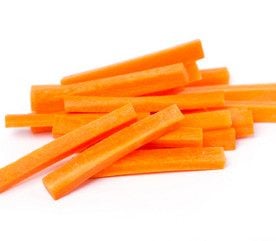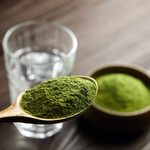Shopping for Sweets with Diabetes
Snacking isn't right for everyone who has diabetes, but for some people, especially those who go more than four or five hours between meals, snacks have a place on the menu. The trick is to choose healthy munchies.

Unfortunately, many of the items in the “snack aisle” are filled with cheap ingredients such as high-fructose corn syrup and hydrogenated oil that make good profits for the manufacturers but do little or nothing for you besides upping your consumption of empty calories, dangerous fats and refined carbohydrates, which wreak havoc on blood sugar and contribute to weight gain. Here’s how to select treats that indulge your sweet and salty cravings but won’t lead you astray of your dietary goals. Hint: You’ll be venturing outside the snack aisle.
Head Back to the Produce Department for Pre-Sliced, Pre-Washed Carrot Sticks:
Pop them in the front of your fridge or tote them when you’re on the go in a zip-close bag for a healthy snack anywhere, anytime. With all their fiber and water, carrots fill your tummy with very few calories.
Say Yes to Low-Fat Mozzarella Sticks:
Snacks low in carbs and moderate in fat are rare birds, but this is one of them. Though the sticks may be a little more expensive than pound-sized blocks of mozzarella ounce for ounce, they’re a sound nutritional investment. The 1-ounce servings contain just 70 calories, 4 grams of fat and less than 1 carbohydrate gram. You’ll also know exactly how much cheese you’re adding to a whole-wheat pita pizza if you shred one stick, rather than eyeballing a package of grated cheese.
Buy Single-Serving Boxes of Raisins:
Yes, raisins are higher in sugar than the grapes from which they come. But single-serving boxes will make sure you stick to small portions of this otherwise good-for-you food.
Go Nuts (in Moderation):
Even though nuts are high in calories, studies find that people who eat nuts tend to weigh less. And Harvard researchers found that women who regularly ate about a handful of nuts five times a week were 20 percent less likely to develop type 2 diabetes as those who didn’t. The benefits probably come from nuts’ blend of protein and good-for-you fats, which make nuts an ideal snack. Just be sure to buy the no-salt versions. Almonds in particular are excellent sources of vitamin E, an antioxidant that may protect against kidney damage and eye and nerve complications.
Choose Low-Fat, Whole-Grain Crackers:
If the cracker you usually eat leaves a ring of oil after you’ve placed it on a napkin, then you know it’s time to switch. Buy a brand that contains at least 3 grams of fiber per serving (about six small crackers). Make sure it doesn’t contain any trans fats (avoid anything with the word “hydrogenated” on the ingredient list), which are linked to heart disease.
Buy Granola Bars, But Choose Carefully:
Some granola bars, with lots of added sugar and little fiber, might as well be candy bars. But if you look hard, you can find a brand that contains no less than 5 grams of fiber and no more than 150 calories per bar. Some high-fiber bars contain as many as 9 grams of appetite-curbing fiber. It also doesn’t hurt to see what effect your favorite granola bar has on your blood sugar; just check your blood sugar two hours after eating one. Once you find a good brand, buy a box and stash a few in your handbag or in your glove compartment for quick on-the-go snacks.
Look for 100-Calorie Snack Packs:
Snack manufacturers are now offering everything from granola bars and cookies to crackers and potato chips in 100-calorie, snack-pack portions. Though many of these snacks are high in fat and sugar and are therefore best eaten as occasional treats, you can keep your caloric and fat intake in check by occasionally indulging in one of these pre-portioned bags.
Ignore Sales on Unhealthy Snacks:
A “buy one, get one free” sale on potato chips may sound too good to pass up, but it isn’t. If you take them home (even if you have the intention of buying them for someone else in the house), you’re bound to eat them.
Skip the Fat-Free Cookies:
Manufacturers usually just add more sugar to these, and research shows that most people will eat more of them than they would the regular version.
Also Skip the Sugar-Free Ice Cream:
In some cases, manufacturers use sugar alcohols as sweetening agents in sugar-free products, which can cause intestinal gas and diarrhea. People with diabetes may have decreased motility in their gastrointestinal tract as it is, and these foods could make their digestive troubles worse. Also, sugar alcohols contain calories, so though they may be sugar-free, they’re not calorie-free and can raise blood sugar. Enjoy a small portion of a reduced-fat ice cream or frozen yogurt instead.
Get Your Chocolate Fix from Frozen Fudge Bars or Ice Cream Sandwiches:
Low-fat ice cream sandwiches are lower in carbohydrates, fat and calories than most chocolate treats. Just avoid ice cream bars covered in a chocolate coating because the coating tends to be made from tropical oils, which are high in saturated fat. At just 88 calories and 1 gram of fat each, Fudgesicles are much better bets than candy bars if you’re watching your waistline.
Snack on Dark Chocolate Chips:
To satisfy a chocolate craving, dole out five or six of the semisweet chips used to make chocolate-chip cookies. Dark chocolate is extremely rich in antioxidants that protect your heart as well as the rest of your body from cell-damaging free radicals.
Always Check Food Labels for Saturated Fat and Sodium:
For people with diabetes, these are the crucially important pieces of data. Why? Diabetes puts you at a higher risk for developing heart disease so no more than 7 percent of your caloric intake should come from saturated fat (for a 2,000-calorie-a-day diet, that’s a maximum of 15 grams of fat). And because having diabetes typically means having higher blood pressure, your intake of milligrams of sodium should be equal to or less than the number of calories you eat a day (in other words, no more than 2,000 milligrams of sodium in a 2,000-calorie diet).
Sugar By Any Other Name:
Sugar is a simple carbohydrate devoid of any nutritional benefits. And even if an ingredient label doesn’t list “sugar”; that doesn’t mean there isn’t any. Manufacturers use more kinds of sugar than you can shake a stick at, and it’s worth familiarizing yourself with some of them so you’re not fooled into thinking an item is better for you than it is. Look for any of these:
- Amazake
- Brown sugar
- Carob powder
- Corn syrup
- Dextrose
- Evaporated cane juice
- Fructose
- Fruit juice concentrate
- High-fructose corn syrup
- Honey
- Maltose
To get a sense of how much sugar you’re really eating, check the nutrition label for “Sugars” listed in grams. Every 4 grams is equivalent to a teaspoon of sugar. Experts suggest we limit our sugar intake to just 12 teaspoons a day from all food sources.



